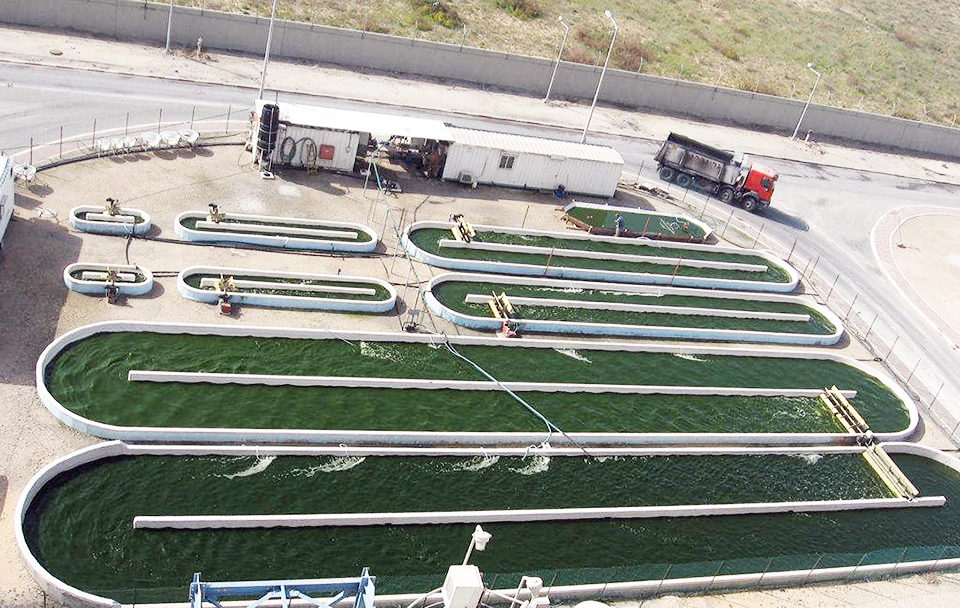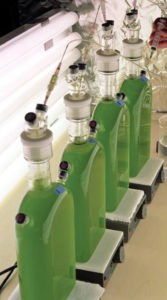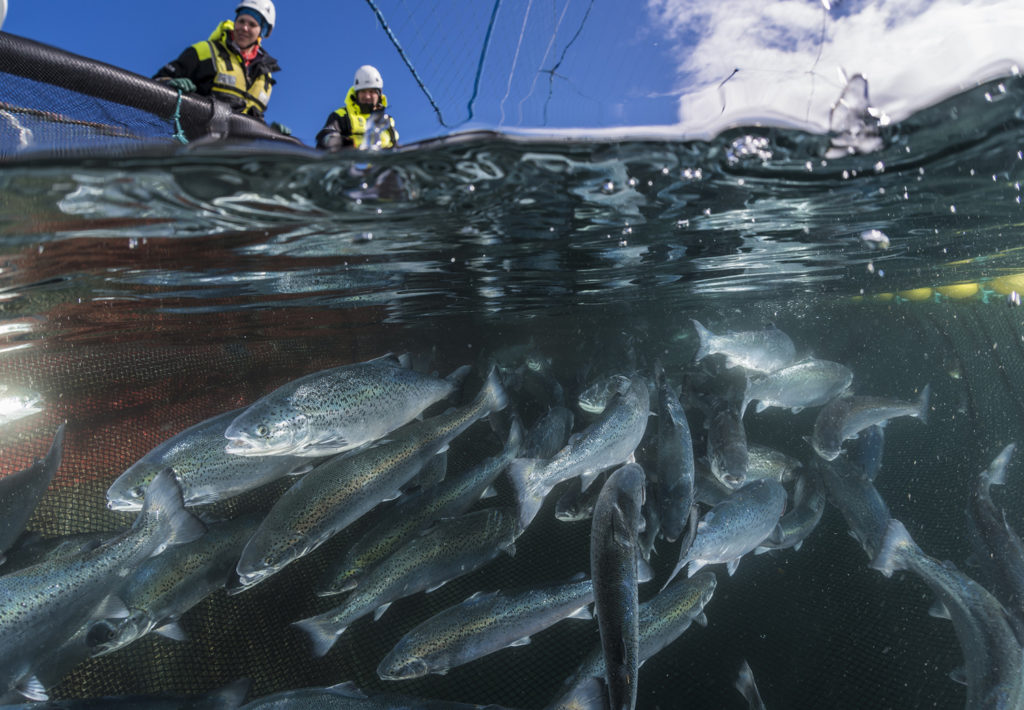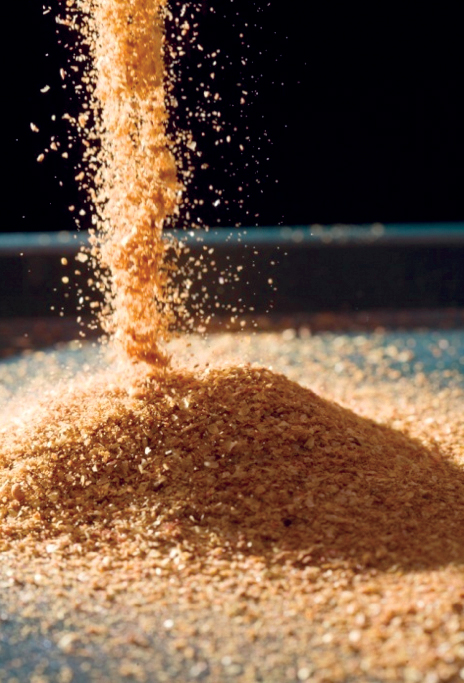Technological challenges remain for large-scale production of microalgae

Costs for energy, especially crude oil, have skyrocketed, and global consumption of fossil fuels continues to rise. Using United States Department of Energy crude oil estimates for the proved world reserves and daily global consumption, one can project that recent rates of crude oil consumption will exhaust the proved world reserves in approximately 36 years. The need for sustainable alternative fuels has recently drawn greater public attention to the possibility of growing microalgae for biofuel production, especially biodiesel. While there is potential for microalgae, technological challenges and other obstacles must be met for the large-scale production of microalgae to become a commercial reality.
Algae production
While there currently is no significant production of algae for biofuel, several thousand tons are farmed commercially each year. These algae are used for nutraceuticals, food additives or nutritional supplements. Several commonly produced species of microalgae include Spirulina, Chlorella, Dunaliella and Haematococcus.
Approximately half of these algae are produced in China. The remainder is farmed in Japan, Taiwan, the United States, Australia and India. Microalgae are also cultured in much smaller quantities as food for rotifers, zooplankton or larval shrimp and bivalves.
There are two basic systems for microalgae production: photobioreactors and open ponds. Photobioreactor systems are more prevalent, primarily because they are well suited to small-scale production. They are most commonly used by government and university labs, and small projects for research and demonstration purposes. However, most large-scale, commercial microalgae biomass production is done in open ponds.
Photobioreactor systems are closed, self-contained systems that continuously pump water containing algae through clear tubes, spheres or plastic bags of various sizes, where algae are exposed to light for growth. Martek Corp. in Kentucky produces algae using a fermentation process in which algae are given starch/sugar in the absence of light to produce omega-3 fatty acids for the nutraceutical market.
Microalgae fuels
Several fuels can be derived from microalgae. These include hydrogen, methane, biodiesel/oil and ethanol. No plausible commercial technology has been demonstrated for hydrogen. Methane can be effectively generated from algae produced in wastewater treatment ponds. While ethanol could be produced from algal starches and sugars, not much effort has been devoted to producing ethanol from algae. Most recent work has focused on the development of biodiesel from lipids/fatty acids that can be produced by certain species of microalgae.
It is a popular perception that future energy shortages in the United States might be solved with the “scum” or moss found in most ponds. Unfortunately, very few species of algae contain enough oil to be suitable candidates for biofuel production. Those with high oil content grow very slowly. Algal strains must be carefully selected and/or developed.
Three very important attributes are high oil content, maximum biomass production and ease of harvest. The algae must perform well in monoculture and be resistant to contamination by undesirable species. The algal species must also be tolerant of the environmental conditions – light level, oxygen concentration, temperature, water quality – where they are farmed.
Resource requirements
Some basic resources are needed for large-scale microalgae biomass production. The climate must foster good algal growth. Annual temperatures have to be sufficiently warm to promote long-term, rapid growth. There must be enough sunlight for sustained photosynthesis. Large quantities of water are needed to fill and refill ponds.
Pond construction requires relatively flat topography with suitable clay soils. Last but not least, a large and readily renewable supply of on-site carbon dioxide is necessary to maintain algal photosynthesis and oil production in a highly eutrophic pond environment.
Pouring a vial of algae into a 1-ha pond will not reliably establish the desired algal species. Starter cultures of 1 to 2 percent of the anticipated harvest biomass are first cultured in photobioreactors. These starter cultures are then used to seed intermediate pond/raceway systems or added directly to large production ponds. Ponds used for large-scale microalgae production should be one to several hectares in size.
Harvesting challenges
Harvesting microalgae poses one of the big technological challenges. In his Microalgae Biofuels – A Brief Introduction, John Benemann indicated that 20 to 40 percent of pond biomass must be harvested daily. The algae also have to be concentrated 30-fold.
Bioflocculation – cell clumping – has been explored. However, chemical additives are often needed to augment the formation of algal cell aggregates, causing them to drop out of the water column. This must be done with minimal or no chemical inputs to limit contaminants in the fuel produced. An efficient, low-cost harvest technology is needed.
Nonetheless, harvesting is just the beginning. Algal cells must be disrupted to retrieve the oil, and solvents are necessary to extract the oil. Mechanical separation is required to remove unwanted cellular by-products and wastes. Then the recovered oil needs further processing to produce a usable fuel.
Other technical issues
Several potential technical problems require further solutions. Algal starter cultures are begun with one algal cell or very few cells, but many species of algae are single-celled plants. The final biomass harvested from a pond represents, at the least, millions to billions of cell divisions that originated from one or only a few cells. It is inevitable that gene mutations will occur, causing “genetic drift.”
This and fluctuations in nutrients or other variables can lead to lower oil content than what is needed to be cost effective. Unwanted and invasive algal species can contaminate a crop, reducing oil yields, particularly in open ponds. Grazers that feed on microalgae, such as fungi, protozoa and zooplankton, are an ever-present threat that can substantially reduce harvest biomass.
Algae advantages

Algae offer some advantages over terrestrial plants for biofuel production. Algal generation times (cell division) and population growth take place over hours and days. Terrestrial plant growth and reproduction typically occur in time frames of months to years.
The rapid cell growth and reproduction cycles of many algal species make genetic strain development or modifications easier and potentially much faster. Moreover, using algae for biofuel production would spare corn and soybean for consumption as food by humans.
With growing concerns about the accumulation of carbon dioxide in our atmosphere and global warming, some view microalgae biomass production as a potential method for removal or abatement of atmospheric carbon dioxide. The idea is to couple algal biofuel production with coal-fired power plants. Carbon dioxide from the power plant flues would provide the substantial volumes needed by algae for large-scale biomass production.
University of Kentucky researchers estimated that 2,000 to 2,400 ha of ponds would be needed to handle the carbon dioxide released by a 500-megawatt power plant. The power plant would of course have to be situated in a location with a large water supply and suitable soils/topography for pond construction. Furthermore, one must evaluate the energy inputs used to remove flue carbon dioxide and produce algae, as well as the amount of energy derived from the algae harvested.
Production economics
Currently, the economics of algae production are daunting obstacles to the commercial development of algal fuel. In 2009, Benemann reported that the lowest costs for producing Spirulina are U.S. $5,000 per metric ton. He extrapolated these costs to the production of algae with 25 percent recoverable oil and projected a price tag of $20,000 per metric ton, 20 to 30 times higher than for vegetable oil at recent peak prices.
The resources and infrastructure needed for large-scale microalgae biomass production are expensive. A free source of carbon dioxide could be crucial. The costs of intensive management and the equipment for photobioreactor systems are prohibitive, especially for thousands of hectares of clear containment vessels with the accompanying pumps and plumbing needed. Production in large ponds appears to be more cost effective.
University of Kentucky researchers estimated production costs for algal bio-diesel at U.S. $18-$30/gal ($4.76-$7.93/L). Benemann estimated overall pond production costs for 25 percent useable algal triglycerides of at least $40,000/ac ($98,840/hectare) for an annual yield of 1,500 gal (5,680 L) of oil. Fuel prices of $4.00/gal ($1.06/L) will not cover capital and operating costs. Ethanol and biodiesel from terrestrial plants are more price-competitive alternatives with crude oil prices at $100/barrel.
Environmental limitations
Producing algae for fuel has environmental limitations. Locations with ample sun and ideal temperature ranges are commonly found in deserts, where water and clay soils are usually scarce. There must be sufficient water, light and carbon dioxide for the eutrophic algal production ponds.
The algae populations are so dense that light cannot penetrate to any appreciable depth. The algal biomass and rate of photosynthesis are so great that carbon dioxide is removed from the water faster than it can be replaced by diffusion from the atmosphere. The high growth rates of algal blooms can rapidly deplete nutrients also. The respiration and photosynthesis associated with this large biomass and speedy growth can cause large swings in pH, destabilizing conditions in the production environment.
Perspectives
While biofuel production from algae is technologically feasible, a number of research and development challenges remain. Greater biomass and faster growth must be achieved. Algal species with higher oil content are needed. Better methods for concentrating and harvesting are crucial. More cost-effective production systems are essential.
A successful solution may require combined objectives. Perhaps algal fuel production can be linked to wastewater treatment and sales of by-products as feed additives and nutraceuticals.
(Editor’s Note: This article was originally published in the July/August 2010 print edition of the Global Aquaculture Advocate.)
Now that you've reached the end of the article ...
… please consider supporting GSA’s mission to advance responsible seafood practices through education, advocacy and third-party assurances. The Advocate aims to document the evolution of responsible seafood practices and share the expansive knowledge of our vast network of contributors.
By becoming a Global Seafood Alliance member, you’re ensuring that all of the pre-competitive work we do through member benefits, resources and events can continue. Individual membership costs just $50 a year.
Not a GSA member? Join us.
Author
-
William A. Wurts, Ph.D.
Senior State Specialist for Aquaculture
Kentucky State University Cooperative Extension Program
P.O. Box 469
Princeton, Kentucky 42445 USA[117,100,101,46,121,107,117,64,115,116,114,117,119,119]
Tagged With
Related Posts

Innovation & Investment
Artemia, the ‘magic powder’ fueling a multi-billion-dollar industry
Artemia, microscopic brine shrimp used as feed in hatcheries, are the unsung heroes of aquaculture. Experts say artemia is still inspiring innovation more than 50 years after initial commercialization. These creatures are much more than Sea-Monkeys.

Aquafeeds
Can corn fuel aquaculture’s growth? Veramaris says yes
The benefits of omega-3 fatty acids to human health are well known. Fish need them too. To supplement current supplies from wild-caught fish, one innovative venture is turning to the corn fields of Nebraska – yes, Nebraska – for answers.

Aquafeeds
A look at corn distillers dried grains with solubles
Corn distillers dried grains with solubles are an economical source of energy, protein and digestible phosphorus to reduce feed costs and fishmeal usage.

Aquafeeds
A new nutrient for aquaculture, from microbes that consume carbon waste
Biotechnology firm NovoNutrients aims to produce a line of nutraceutical aquafeed additives as well as a bulk feed ingredient that can supplement fishmeal. Its process includes feeding carbon dioxide from industrial gas to a “microbial consortium” starring hydrogen-oxidizing bacteria.


